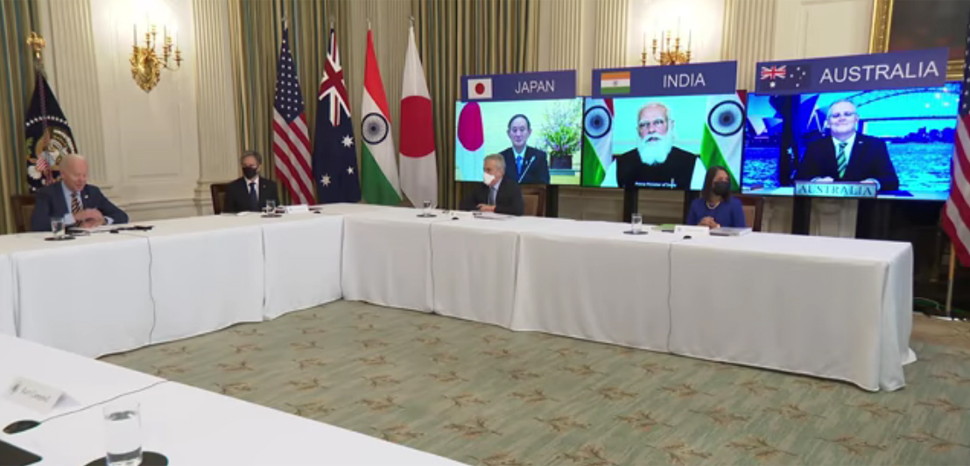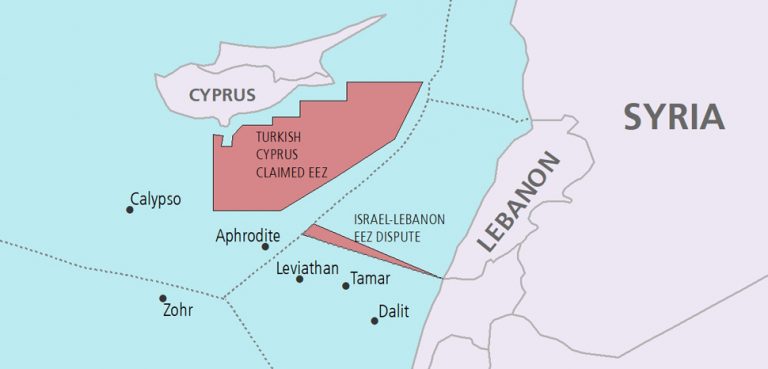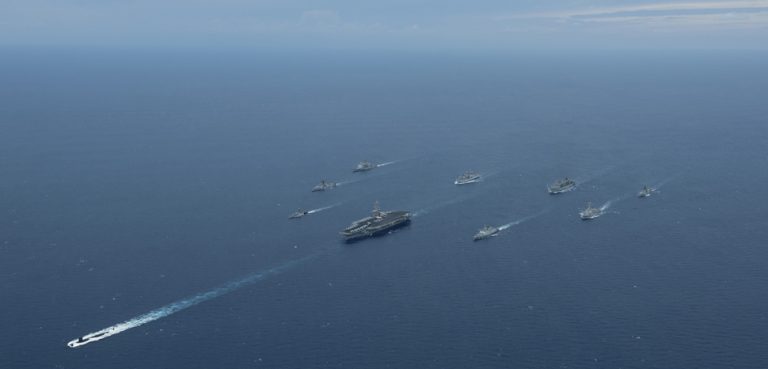The evolution of the Quadrilateral Security Dialogue (hereon, Quad) —comprising of India, US, Japan and Australia — has quickly become one of the most crucial aspects shaping Indo-Pacific geopolitics. Calling it an “exclusive clique” that targets “third parties”, China’s reactions to the Quad have until now been largely constrained, even as bilateral ties between Beijing and the ‘Quad 4’ have been adversely impacted.
A major factor shaping such mild responses from China has been the fact that even within the Quad, differences between the four countries have largely limited its evolution into an immediate threat for Beijing. A clear example of this has been the absence of a joint statement post meetings of the Quad, accentuated by an aversion on the part of India, Japan and Australia to appear as explicitly engaging in an anti-China mechanism despite their own tense ties with Beijing. However, the recent virtual summit of the Quad leaders marked an important upgrade to the framework, giving the hitherto largely strategic dialogue a clear political outlook.
Quad summit breaks new ground
What does involvement in the recent Quad Leadership Summit (QLS) denote vis-à-vis the China policies of the ‘Quad 4,’ and how does it shape the individual, regional, and global ambitions of those states involved?
Following active participation by the leaders of Quad countries – Narendra Modi of India, Yoshihide Suga of Japan, Joe Biden of the US, and Scott Morrison of Australia –the QLS released, for the first time since the revival of the Quad in 2017, a joint statement enunciating on, and titled, “The Spirit of the Quad.” Such a Quad ‘spirit’ has marked its evolution — and expansion— as a premier security grouping shaping the future of the Indo-Pacific geo-political landscape. Ranging from a focus on climate to vaccines to emerging technologies, the various sub-groups created at the QLS clearly showcase the extension of the Quad into a more sustainable and future-oriented venture.
While no direct mention to China was made, proceedings at the QLS highlight the aspirations of the ‘Quad 4’ to both unite in limiting China’s assertive rise and to build the Quad as premier Indo-Pacific security dialogue in its own respect. In other words, while the Chinese threat is a uniting factor vis-à-vis the Quad’s long-held ambition to build a ‘free’ and ‘open’ Indo-Pacific, the group wishes to grow as a cohesive, broad, and sustainable mechanism looking beyond China.
That being said, the QLS did implement strategies that Chinese President Xi Jinping will undoubtedly view as anti-China. For instance, the establishment of a ‘vaccine partnership’ emerges as a direct attempt to counter China’s ‘Health Silk Road.’ Foreign Ministry Spokesperson Zhao Lijian has already strongly rejected such a “vaccine divide.” Meanwhile, the establishment of the Critical and Emerging Technologies Working Group seeks to limit China’s dominance in the technological supply chain. Here, the Quad’s reported plans to create a new ‘rare-earth procurement chain’ —building on attempts to break tech-supply chain dependency on China — will not be taken lightly by Beijing which holds the largest reserve of rare-earths in the world and has hence dominated global technology supply chains.
No time like the present for Quad leaders
So, why a ‘leadership summit’ and why now? China’s great-power rivalry with the US, border clash with India, ‘all-time low’ ties with Australia, and an ‘exodus’ of Japanese manufacturing from China are vital determinants of what Beijing views as ‘Cold War mentality’ politics focused on limiting China’s rise. Holding such a summit as China’s ‘Two Sessions’ conclude — and as important bilateral meetings between the new US administration and the Quad countries begin, such as the upcoming visit of US Secretary of Defense Lloyd Austin to India and the first US-Japan 2+2 under Biden — sends a clear signal of growing synergy between the ‘Quad 4’ to Chinese President Xi Jinping. Amid President Xi’s focus on achieving the ‘two centennial goals’, the Quad countries (except the US) have been careful in using the platform of the Quad for their own national interest priorities rather than to build a ‘coalition’ against China. Even at the second ministerial of the Quad, it was only then US Secretary of State Mike Pompeo who targeted the Chinese Communist Party (CCP) and China.
In the US, despite division on vital domestic and international policies, there is widespread bipartisan party consensus over the threat China’s revisionism poses to Washington. Biden has – as per statements by his National Security Advisor (NSA) Jake Sullivan – shown an inclination to build on the policies of the Trump administration, especially regarding strengthening the Quad. Speaking at the U.S. Institute for Peace’s (USIP) 2021 ‘Passing the Baton’ webcast discussion, Sullivan termed the grouping as “fundamental” and “a foundation upon which to build substantial American policy in the Indo Pacific region.” Therein, the QLS, proposed by the US, marks an extension of Trump-era attempts to build a China-containment arc.
The QLS’ timely and successful proceedings played a major role in strengthening Washington’s position before the first high-level meeting between US-China under Biden. As predicted, the ‘Alaska Summit’ opened on a contentious note, with both sides voicing concerns about the other; the summit concluded without success in the traditional sense, though it was still crucially important. The ‘leadership summit’ marks a step towards one of Biden’s key foreign policy goals: making America “lead again” by rebuilding alliances and partnerships. In this context, the QLS emerges as crucial to Biden’s turn-around towards multilateralism. Even though shifts from internationalism to isolationism and vice-versa have been undertaken by the US, such a histrionic and swift reverse is unprecedented in modern American foreign policy. Hence, redefining a leadership role for Washington – especially following an erratic Trump administration – has become the defining arc of Biden’s foreign policy overtures, especially vis-à-vis the Indo-Pacific. The QLS also sets the stage to ‘strengthen the coalition of democracies’ and convene a global ‘Summit for Democracy’ which Biden has been campaigning for.
For Suga, containing the worsening economic and health impacts of the COVID-19 pandemic is directly linked to his falling approval ratings and hopes of prevailing in the next general election in October 2021. With hopes pinned on a successful Olympics to revitalize the economy, Suga has upheld his recognition as a ‘continuity’ leader to Shinzo Abe. His focus on nurturing the Quad, revived by Abe in 2017, has played a major role in his foreign policy overtures; Tokyo held the historic second Quad ministerial meet in October 2020, marking Suga’s first multilateral engagement. Hence, despite divided China lobbies in Japan leading to political pressure, Suga’s commitment to Japan’s ‘Free and Open Indo-Pacific’(FOIP) vision has stayed resolute. In Biden’s first telephone conversation with Suga, building on his goal to strengthen alliances, the president reaffirmed the commitment that the US-Japan alliance extends into the East China Sea (ECS) – where Japan-China are embroiled in a dispute over the Senkaku/Diaoyu islands. Such overtures have strengthened the US hand in Japan’s China outlook. A clear example of this is evident in the recently concluded US-Japan 2+2, wherein both sides issued a joint statement directly criticizing China’s assertive actions, describing them as “inconsistent with the existing international order,” while reiterating US commitment to defend Japan under Article V of their security alliance treaty, “which includes the Senkaku Islands.” Suga’s legacy is being defined by the pandemic; how he maneuvers the critical geopolitical environment with a focus on Japan’s China policy and its role as a regional power can add positive value to ebbing public support. Taking the Quad mantle forward is a step in that very direction.
Australia’s ties with China are at an “all time low.” Canberra’s focus on economic decoupling from China remains constrained though, as mutual dependance limits such an undertaking. Nonetheless, the pandemic has left some indelible marks on the Australia-China equation, with China’s trade bans on Australia in response to the latter’s request for a query into the origin of the coronavirus becoming major economic irritants for the Morrison government. Australia’s enthusiasm for the QLS is hence drawn on such parameters, with Morrison being one of the first leaders to officially endorse and confirm participation. Over the past year, Australia has actively sought to improve ties with Quad partners; it upgraded ties with India to a Comprehensive Strategic Partnership, finalized in principle a long-pending Reciprocal Access Agreement (RAA) with Japan, and continued strengthening its defense alliance with the Washington by signing the first US-Australia Cyber Training Capabilities Project Arrangement focused on building a virtual training range. Nonetheless, Morrison has also been trying to rebuild ties with China –which is Australia’s largest trade partner. However, China has thus far rebuffed such advances as ‘disingenuous.’ Hence, Australia’s focus on building the Quad narrative – as it begins to accept that China’s ire is not easily dissipated – has emerged as a natural strategic alternative to attempting appeasement of Beijing.
India, for its part, has viewed the Quad as an extension of its pluralistic foreign policy outlook which has been defined by New Delhi’s delicate balance of limiting China’s growing power while building economics-based bilateralism with Beijing. Modi’s involvement in the QLS –especially at a time when the tenth round of disengagement talks between India-China have just concluded with no clear resolution still – shows a tilt of the balancing scales towards overtly standing up to China’s growing assertiveness. India’s active participation and endorsement of the Quad – and its growing sub-structures – are crucial to the grouping’s success.
History has shown that most of the Cold War era military alliances with Asian countries – like Southeast Asia Treaty Organization (SEATO) or Central Treaty Organization (CENTO) – failed due to the unwillingness shown by regional powers to convert them into oppositional structures to common threats. More importantly, India – as the ‘net security’ provider of the region and the fulcrum of the Indo-Pacific – has adhered to its non-alliance stand, thereby excluding itself from participating in such frameworks. As the Quad evolves – and talks of it becoming an ‘Indo-Pacific NATO’ become common parlance – India’s support for the grouping becomes more and more vital. More importantly, post-Quad meeting statements by the three countries apart from India have all at one point or the other incorporated the concept of ‘inclusive’ in defining their Indo-Pacific vision. Such diplo-speak is a major win for India, which has long espoused a ‘free, open and inclusive’ maritime vision, therein highlighting its ‘power-partner’ parity with China. Such a sentiment is central to India’s acceptance of a pluralistic, multipolar regional order; even post Galwan, India has reiterated that it will ‘never be a part’ of alliance frameworks. Hence, Modi’s vision that the Quad will “remain an important pillar of stability” for the Indo-Pacific and participation in the QLS, despite factoring in China’s displeasure, is based on his expectation that the grouping will steady the power imbalance and identity politics in the region, especially as it expands its focus into other areas and does not appear to be anti-China or militarist in nature.
Nonetheless, it is important to remember that all five —Modi, Suga, Biden, Morrison and Xi —are nationalist and populist leaders. Ultimately, national interest and national identity supersede other dimensions, as seen in Japan’s reluctance to expand the Group of Seven (G7) to include India and Australia (its Quad partners) so as to remain the sole Asian power in the group. While the Quad’s future is heavily reliant on decisions the US makes, factors like assertive actions by China, regional politics of the Indo-Pacific, leadership in the Quad countries and economic ties between China ‘Quad 4’ amidst a restructuring of global supply chains are also important considerations. Provoking China at a time when economic dependance on Beijing is high and the US commitment to Asian security remains vague is not an appeasing option, even as the Australia-Japan-India trilateral has initiated the Supply Chain Resilience Initiative (SCRI) to create sustainable supply chains post-pandemic. Moreover, an ‘elusive’ pursuit of militarizing the Quad along the lines of NATO for the Indo-Pacific is dependent mostly on the strategic maneuvering India, Japan and Australia imbibe in their respective China policies. Hence, while the Quad’s politicization via the QLS has marked a welcome upgrade to the evolving strategic dialogue, the initiation of a political gateway led by populist leaders with a lot at stake vis-à-vis voter mandates can slow the progress of such discussions. How the QLS shapes the Quad in the future is yet to be seen; however, the grouping would not be remiss should it begin the creation of a charter to guide its future –and the future of its expanding sub-groups.
The views expressed in this article are those of the authors alone and do not necessarily reflect those of Geopoliticalmonitor.com.




